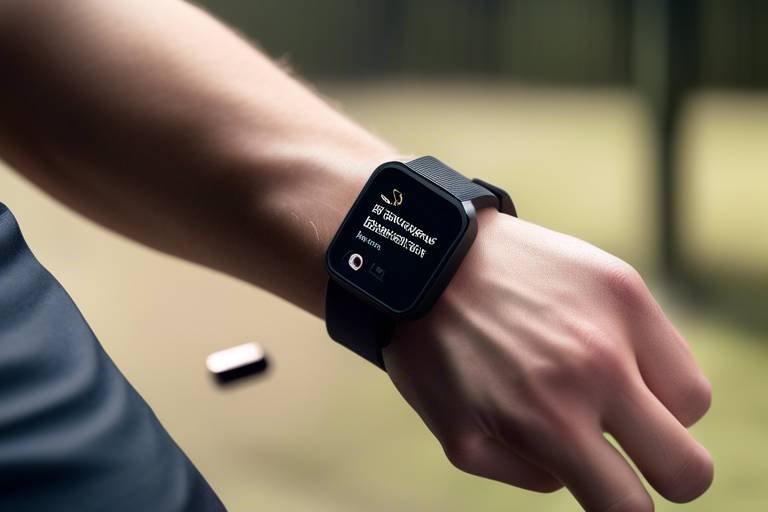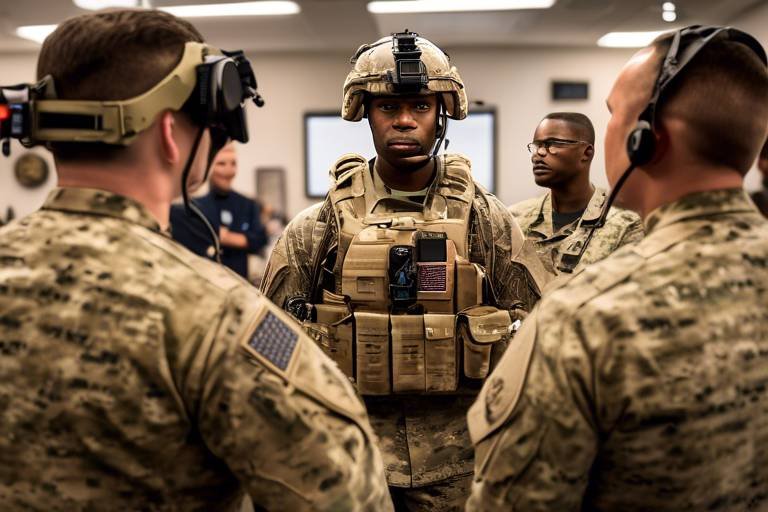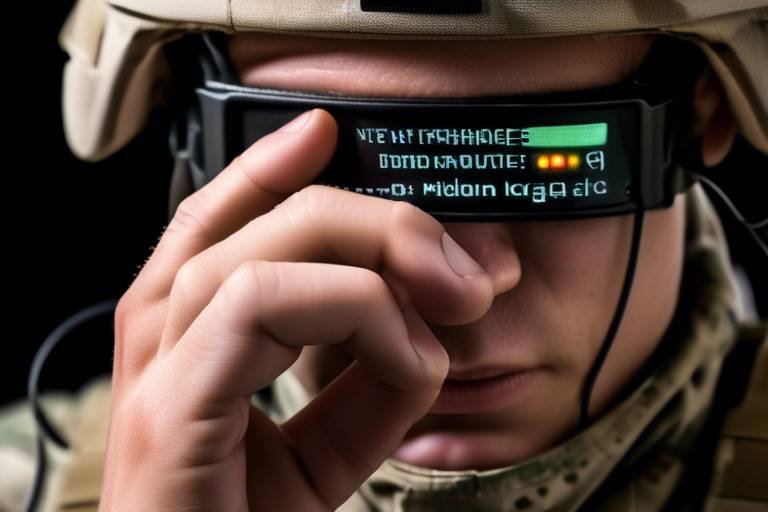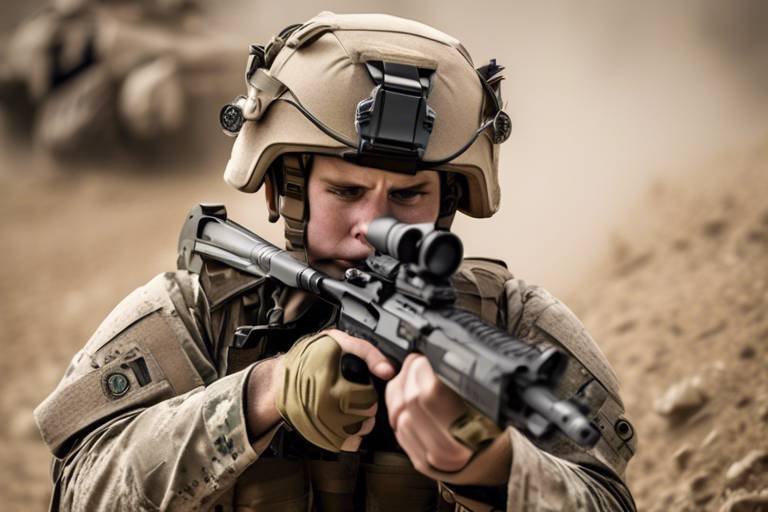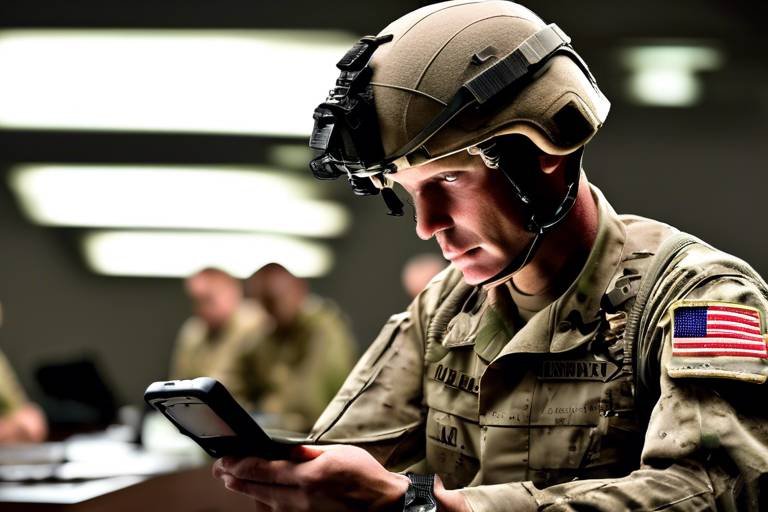The Role of Smart Wearables in Aviation Operations
In recent years, the aviation industry has experienced a remarkable transformation, largely driven by the advent of smart wearables. These innovative devices are not just trendy gadgets; they are revolutionizing how aviation operations are conducted. With a focus on enhancing safety, efficiency, and communication among crew members and ground staff, smart wearables are becoming indispensable tools in the cockpit and beyond. Imagine a world where pilots can monitor their health metrics in real-time, maintenance crews can troubleshoot aircraft issues remotely, and crew members can communicate seamlessly without disrupting their workflow. This is not just a dream—it's the reality that smart wearables are creating.
As we delve deeper into the role of these devices, it becomes clear that they are not merely enhancing existing processes but are also paving the way for future advancements in aviation. By integrating technology into daily operations, airlines are not only improving the experience for their passengers but also ensuring that their crews are operating at peak performance. So, how exactly are smart wearables making waves in the aviation sector? Let's explore some of the key areas where these devices are making a significant impact.
One of the most critical aspects of aviation is ensuring that pilots are operating at their best. Smart wearables play a vital role in this area by monitoring various health metrics such as heart rate, stress levels, and even sleep patterns. By providing real-time feedback, these devices help pilots optimize their performance and reduce fatigue. Just think about it: a pilot who is well-rested and aware of their physiological state is much more likely to make sound decisions in critical situations. This capability not only leads to safer flights but also fosters an environment where pilots can focus on what truly matters—flying the aircraft.
Communication is the backbone of any successful operation, especially in aviation. Smart wearables facilitate real-time communication among crew members, ensuring that vital information is shared instantly. This immediacy enhances coordination and operational efficiency during flights. With devices like smart glasses and headsets, crew members can stay connected without compromising their workflow or attention to critical tasks. Imagine a scenario where a flight attendant can receive updates about passenger needs without having to leave their post; this is the kind of efficiency that smart wearables bring to the table.
Devices such as smart glasses and headsets are game-changers in terms of communication. They allow crew members to engage in hands-free conversations, which means they can focus on their responsibilities while staying in the loop. This technology not only streamlines communication but also minimizes the chances of errors that can occur during manual information exchanges. In an industry where every second counts, these devices can make a world of difference.
Smart wearables can be integrated with cockpit systems, giving pilots immediate access to flight data and alerts. This integration streamlines their workflow and enhances situational awareness, allowing pilots to make informed decisions quickly. Imagine having crucial flight information displayed right in your line of sight—this is the reality that smart wearables are creating for pilots, ensuring they are always one step ahead.
Another significant advantage of smart wearables is their ability to enable seamless data sharing among crew members. Whether it's quick updates on flight status, weather conditions, or other critical information, these devices allow for instant communication without manual intervention. This capability not only saves time but also enhances the overall safety and efficiency of flight operations.
Health and safety are paramount in aviation. Smart wearables can track health metrics such as heart rate and stress levels, ensuring that crew members are fit for duty. By monitoring these factors, airlines can proactively address any concerns before they escalate into serious issues. This preventative approach is crucial in an industry where the stakes are incredibly high, and every decision counts.
Smart wearables are not just limited to enhancing crew performance; they also play a pivotal role in maintenance operations. By providing real-time data and diagnostics, these devices help maintenance crews reduce downtime and ensure that aircraft are maintained to the highest safety standards. Think of it as having a personal assistant that keeps track of all the intricate details of an aircraft's health.
Technicians can leverage smart glasses to receive remote assistance from experts, enabling faster problem-solving and reducing the need for on-site consultations. This capability is especially beneficial when dealing with complex issues that require immediate attention. With the help of wearables, technicians can access expert guidance in real-time, ensuring that aircraft are back in the air as quickly as possible.
Wearables can also collect and analyze data on aircraft performance, helping maintenance teams predict issues before they arise. By scheduling proactive maintenance, airlines can avoid costly delays and ensure that their fleets are operating smoothly. This data-driven approach not only enhances safety but also contributes to overall operational efficiency.
- What are smart wearables in aviation? Smart wearables are devices such as smart glasses, smartwatches, and headsets that enhance communication, performance, and safety in aviation operations.
- How do smart wearables improve pilot performance? They monitor health metrics like heart rate and stress levels, helping pilots optimize their performance and reduce fatigue.
- Can smart wearables assist in maintenance operations? Yes, they provide real-time data and diagnostics, allowing maintenance crews to streamline operations and reduce downtime.
Enhancing Pilot Performance
In the fast-paced world of aviation, where every second counts and decisions can mean the difference between safety and disaster, pilot performance is paramount. Smart wearables are revolutionizing how pilots manage their health and performance metrics. Imagine a world where a pilot's fatigue levels are monitored in real-time, allowing for timely interventions that can prevent accidents caused by exhaustion. This is not just a dream; it's becoming a reality thanks to advanced wearable technology.
These devices can track a variety of health metrics, including heart rate, stress levels, and even sleep patterns. By providing pilots with insights into their physical and mental states, wearables empower them to make informed decisions about their fitness for duty. For instance, if a pilot is experiencing elevated stress levels or inadequate rest, the wearable can alert them to these issues, prompting them to take necessary actions such as engaging in relaxation techniques or opting for a brief rest period before flying. This proactive approach to health management not only enhances safety but also optimizes overall performance.
Furthermore, the integration of wearables with flight operations can create a seamless workflow. For example, smart watches or fitness bands can be programmed to sync with cockpit systems, providing pilots with critical flight data at a glance. This means that instead of flipping through manuals or waiting for updates, pilots can access real-time information directly on their wrist, allowing them to focus on what truly matters—flying the aircraft safely. The benefits of this technology extend beyond just immediate access to information; they also foster a deeper understanding of individual performance patterns over time.
To illustrate the impact of smart wearables on pilot performance, consider the following table:
| Health Metric | Impact on Performance | Wearable Technology Role |
|---|---|---|
| Heart Rate | Indicates stress and fatigue levels | Continuous monitoring and alerts |
| Sleep Quality | Affects cognitive function and reaction time | Tracks sleep patterns and provides insights |
| Stress Levels | Can impair decision-making abilities | Real-time feedback and stress management tips |
In addition to health metrics, wearables can also provide real-time feedback on performance during training simulations. This means that as pilots practice in simulators, they can receive immediate insights into their physiological responses, allowing for adjustments that can enhance their skills. This kind of feedback loop is invaluable, as it creates a more dynamic and responsive training environment, ultimately leading to better-prepared pilots.
As we look to the future, the role of smart wearables in aviation operations is only expected to grow. With advancements in technology, we can anticipate even more sophisticated devices that will not only monitor health but also analyze performance data in ways we can't yet imagine. The goal is clear: to ensure that pilots are not just flying but are at their peak performance, ready to handle whatever challenges the skies may present.
Improving Crew Communication
In the fast-paced world of aviation, effective communication is not just a luxury; it's a necessity. Imagine a scenario where a flight crew is juggling multiple tasks, from monitoring flight instruments to coordinating with ground staff. In such high-stakes environments, wearable technology emerges as a game-changer, ensuring that vital information flows seamlessly between crew members. With smart wearables, the barriers of traditional communication methods are shattered, paving the way for real-time updates and enhanced coordination.
Wearable devices like smart glasses and headsets are revolutionizing how crew members interact. These tools allow for hands-free communication, meaning that pilots and cabin crew can stay connected without taking their eyes off their critical responsibilities. For instance, a pilot can receive important updates on flight conditions or air traffic without needing to divert their attention from the cockpit. This level of connectivity not only enhances operational efficiency but also significantly reduces the risk of miscommunication, which can lead to serious safety concerns.
Moreover, the integration of smart wearables with cockpit systems is a significant leap forward. Pilots can access flight data and alerts at a glance, streamlining their workflow. For example, if there’s a sudden change in weather conditions, the system can alert the pilot instantly through their wearable device. This immediate access to crucial information boosts situational awareness, allowing pilots to make informed decisions quickly. The ability to communicate effectively in such critical moments can mean the difference between a routine flight and a potential emergency.
Another remarkable feature of these smart devices is their capability for seamless data sharing among crew members. Imagine a scenario where the cabin crew needs to update the cockpit on passenger conditions or any in-flight incidents. With smart wearables, this information can be relayed instantly, eliminating the need for lengthy manual communication. This real-time data sharing not only keeps everyone informed but also enhances the overall safety and efficiency of the flight operations. In essence, smart wearables are not just gadgets; they are essential tools that empower crew members to work in harmony.
In conclusion, the integration of smart wearables into aviation operations is a transformative step towards improving crew communication. By facilitating hands-free communication, integrating with cockpit systems, and enabling real-time data sharing, these devices enhance operational efficiency and safety. As we move forward, embracing this technology will be crucial in ensuring that aviation remains one of the safest modes of transportation available.
- How do smart wearables improve communication among crew members?
Smart wearables facilitate hands-free communication, allowing crew members to stay connected while focusing on their critical tasks. - Can smart wearables integrate with existing cockpit systems?
Yes, many smart wearables can be integrated with cockpit systems, providing immediate access to flight data and alerts. - What types of wearable devices are commonly used in aviation?
Devices like smart glasses and headsets are commonly used for communication and data sharing among crew members. - How does real-time data sharing enhance flight safety?
Real-time data sharing ensures that all crew members are informed of any changes or updates, reducing the risk of miscommunication.
Wearable Communication Devices
In the fast-paced world of aviation, effective communication is paramount. This is where come into play, revolutionizing the way crew members interact during flights. Imagine a cockpit buzzing with activity, where every second counts, and the need for seamless communication is critical. Smart glasses and advanced headsets are not just gadgets; they are lifelines that keep pilots and crew connected without breaking their focus on essential tasks.
These devices are designed to offer hands-free communication, allowing crew members to relay information while keeping their hands on the controls or performing other vital duties. For instance, a pilot can receive flight updates directly through their smart glasses without having to look away from the instruments. This means that crucial information is always at their fingertips, enhancing both safety and efficiency. Moreover, the ability to communicate without the need for traditional handheld devices reduces the risk of distractions, which can be detrimental in high-stakes environments like aviation.
Furthermore, the integration of these wearable devices with existing cockpit systems is a game-changer. Not only do they provide real-time data, but they also allow for immediate alerts about any changes in flight conditions. This integration creates a streamlined workflow, ensuring that pilots are not just reacting to information but are actively engaged in decision-making processes. It’s like having a co-pilot who constantly feeds you the most relevant data without interfering with your concentration.
Additionally, the capability for data sharing among crew members is enhanced through these wearables. Imagine a scenario where a flight attendant can instantly update the cockpit about passenger needs or potential issues, all while attending to their duties. This real-time exchange of information creates a more cohesive team environment, allowing everyone to be on the same page without the need for cumbersome communication protocols. With wearables, the crew can focus on their tasks while still being interconnected, which is essential for maintaining operational efficiency.
In summary, wearable communication devices are not just technological advancements; they are essential tools that enhance safety, efficiency, and teamwork in aviation. By facilitating hands-free communication and integrating seamlessly with cockpit systems, these devices ensure that every crew member is equipped to respond swiftly and effectively to the demands of flight operations.
Integration with Cockpit Systems
The integration of smart wearables with cockpit systems is nothing short of a game-changer in the aviation industry. Imagine a scenario where pilots have immediate access to critical flight data without having to take their eyes off the instruments. This is precisely what wearables can achieve. By seamlessly connecting to cockpit systems, these devices provide real-time data updates, alerts, and notifications directly to the pilot, enhancing their situational awareness and decision-making capabilities.
With smart wearables, the cockpit becomes a hub of information. For instance, a pilot wearing a smart headset can receive instant updates about altitude changes, weather conditions, and even system malfunctions without needing to sift through multiple screens or instruments. This hands-free approach allows pilots to maintain focus on flying the aircraft while still being informed of any changes that may require their immediate attention.
Moreover, the integration can be designed to prioritize alerts based on urgency. For example, critical alerts regarding engine performance or navigation can be highlighted, ensuring they are seen first. This prioritization not only helps in managing the workload but also significantly reduces the risk of overlooking important information during high-pressure situations.
Another fascinating aspect of this integration is the potential for voice commands. Pilots can interact with cockpit systems using voice-activated commands through their wearables. This means that while flying, they can adjust settings, retrieve information, or even communicate with ground control, all without the need to physically manipulate controls. This feature alone can enhance efficiency and responsiveness during critical phases of flight.
To illustrate the benefits of wearable integration with cockpit systems, consider the following table:
| Feature | Benefit |
|---|---|
| Real-time Data Access | Immediate updates on flight conditions enhance situational awareness. |
| Hands-free Operation | Allows pilots to focus on flying while still receiving critical information. |
| Voice Command Functionality | Enables quick adjustments and information retrieval without distraction. |
| Alert Prioritization | Ensures critical alerts are seen first, reducing the risk of oversight. |
In conclusion, the integration of smart wearables with cockpit systems is revolutionizing how pilots interact with flight data. By enhancing communication, improving situational awareness, and streamlining operations, these technologies are setting new standards for safety and efficiency in aviation.
- What are smart wearables in aviation? Smart wearables are devices like smart glasses and headsets that provide pilots and crew with real-time data and communication capabilities.
- How do wearables improve pilot performance? They monitor health metrics and provide immediate access to critical flight data, helping to reduce fatigue and enhance decision-making.
- Can wearables be integrated with existing cockpit systems? Yes, many smart wearables are designed to integrate seamlessly with current cockpit technologies, enhancing their functionality.
- What are the safety benefits of using smart wearables? They help in maintaining situational awareness, reduce distractions, and ensure that pilots receive timely alerts about critical flight information.
Data Sharing Among Crew
In the fast-paced world of aviation, where every second counts, effective communication is paramount. Smart wearables have revolutionized the way crew members share data, transforming what was once a cumbersome process into a seamless and efficient workflow. Imagine a scenario where pilots, flight attendants, and ground staff are all on the same page, equipped with real-time information that enhances decision-making and operational efficiency. With smart wearables, this is no longer just a dream—it's a reality!
These devices enable crew members to receive and share critical updates instantly, eliminating the delays often associated with traditional communication methods. For instance, if a pilot receives an alert about sudden weather changes, they can immediately relay this information to the cabin crew, ensuring that everyone is prepared for any necessary adjustments. This kind of instantaneous data sharing not only improves safety but also boosts the overall performance of the flight crew.
Moreover, the integration of smart wearables into the aviation ecosystem allows for the sharing of various types of data, including:
- Flight Status Updates: Crew members can be instantly informed about any changes in flight schedules, delays, or emergencies.
- Weather Conditions: Real-time weather updates can be shared, allowing the crew to anticipate and respond to changing conditions.
- Passenger Information: Updates on passenger needs or emergencies can be communicated effectively, ensuring a smooth experience for everyone on board.
What sets smart wearables apart is their ability to operate without interrupting the crew's workflow. With hands-free devices, such as smart glasses or headsets, crew members can stay connected while focusing on their primary responsibilities. This is akin to having a personal assistant who whispers important updates in your ear while you’re busy at work—no distractions, just the information you need when you need it.
Furthermore, these wearables can be integrated with existing cockpit systems, allowing for a comprehensive data-sharing network that enhances situational awareness. Pilots can access vital flight data and alerts directly through their wearables, streamlining their operations and minimizing the risk of information overload. This integration ensures that everyone, from the cockpit to the cabin, is equipped with the latest information, promoting a culture of safety and efficiency.
As the aviation industry continues to embrace smart technology, the potential for data sharing among crew members will only expand. With advancements in wearable technology, we can expect to see even more innovative solutions that enhance communication, improve safety, and ultimately transform the way we think about aviation operations.
- How do smart wearables improve communication among crew members?
Smart wearables allow for real-time data sharing, enabling crew members to receive crucial updates instantly without interrupting their tasks.
- What types of data can be shared using wearables?
Data such as flight status updates, weather conditions, and passenger information can be shared seamlessly among crew members.
- Are smart wearables safe to use during flights?
Yes, smart wearables are designed to enhance safety and efficiency without distracting crew members from their duties.
Monitoring Health and Safety
In the high-stakes world of aviation, where every second counts and decisions can mean the difference between safety and disaster, is paramount. Smart wearables are revolutionizing how we keep track of crew members' well-being, ensuring they are always fit for duty. Imagine a scenario where a pilot can continuously monitor their health metrics, such as heart rate and stress levels, in real-time. This capability not only promotes a healthier work environment but also enhances overall flight safety.
These wearables are equipped with advanced sensors that can detect fluctuations in vital signs, alerting crew members to any potential health issues before they escalate. For instance, a sudden spike in heart rate could indicate rising stress levels or fatigue, prompting immediate action. This proactive approach allows for timely interventions, ensuring that crew members are in optimal condition to handle the demands of their roles.
Moreover, the integration of wearables with health management systems creates a comprehensive view of crew health. Data collected from these devices can be analyzed to identify trends and patterns, allowing airlines to implement targeted wellness programs. For example, if a significant number of crew members report high-stress levels during specific flight routes, airlines can take steps to mitigate this, such as adjusting schedules or providing additional support.
Additionally, the real-time health data gathered from wearables can be invaluable during emergencies. In critical situations, having immediate access to a crew member's health metrics can help decision-makers assess the situation more effectively. For instance, if a pilot experiences distress, the crew can quickly determine whether to continue the flight or divert to the nearest airport, prioritizing safety above all.
In summary, the role of smart wearables in monitoring health and safety is not just a technological advancement; it is a game-changer for the aviation industry. By ensuring that crew members are healthy and fit for duty, airlines can enhance safety protocols and improve overall operational efficiency. Investing in such technology is not merely about keeping up with trends; it's about fostering a culture of safety that benefits everyone involved in the aviation ecosystem.
- How do smart wearables monitor health metrics?
Smart wearables utilize sensors to track vital signs such as heart rate, stress levels, and sleep patterns, providing real-time data to the user and management systems. - Can wearables improve crew communication?
Yes, wearables facilitate instant communication among crew members, allowing them to share critical information without interrupting their workflow. - What are the benefits of monitoring crew health?
Monitoring crew health can lead to early detection of potential issues, improved decision-making in emergencies, and overall enhanced safety in aviation operations.
Streamlining Maintenance Operations
In the fast-paced world of aviation, maintenance operations are crucial for ensuring the safety and reliability of aircraft. With the advent of smart wearables, these operations are becoming more efficient and effective than ever before. Imagine a scenario where technicians can access real-time data and diagnostics right at their fingertips, significantly reducing downtime and enhancing the overall safety standards of the aircraft. This is not just a dream; it's a reality brought to life by the integration of wearable technology in maintenance practices.
One of the most significant advantages of smart wearables is their ability to provide immediate access to critical information. For instance, technicians can wear smart glasses that display real-time diagnostics and maintenance checklists while they work on an aircraft. This hands-free approach allows them to focus on the task at hand without constantly referring to printed manuals or handheld devices. Think of it as having a personal assistant that whispers essential information directly into your ear while you work—streamlining tasks and minimizing errors.
Moreover, smart wearables can facilitate remote assistance for technicians. When faced with a complex issue, technicians can connect with experts in real time through their wearable devices. This capability not only accelerates the troubleshooting process but also reduces the need for on-site consultations, which can be time-consuming and costly. Imagine a technician in a hangar, wearing smart glasses, who can instantly call upon an expert thousands of miles away to guide them through a repair. This level of collaboration enhances problem-solving and ensures that aircraft are maintained efficiently.
Another remarkable feature of smart wearables is their ability to gather and analyze data on aircraft performance. These devices can monitor various metrics, such as engine temperature, fuel efficiency, and wear and tear on components. By collecting this data, maintenance teams can identify patterns and predict potential issues before they become critical problems. This proactive approach to maintenance not only saves time and money but also enhances safety by ensuring that aircraft are always in optimal condition. Consider it as having a crystal ball that helps you foresee maintenance needs before they arise, allowing for timely interventions.
| Wearable Technology Benefits | Description |
|---|---|
| Real-time Data Access | Instant access to diagnostics and maintenance checklists enhances efficiency. |
| Remote Assistance | Technicians can connect with experts for guidance, reducing downtime. |
| Predictive Maintenance | Data analysis helps identify potential issues before they escalate. |
In conclusion, the integration of smart wearables in aviation maintenance operations is not just about keeping up with technological trends; it’s about revolutionizing the way maintenance is conducted. By streamlining processes, enhancing communication, and utilizing data-driven insights, these devices are paving the way for a safer and more efficient aviation industry. As we look to the future, it’s clear that smart wearables will play a pivotal role in shaping the landscape of aviation maintenance.
- What types of smart wearables are used in aviation maintenance? Smart glasses, smartwatches, and headsets are commonly used to assist technicians in their tasks.
- How do smart wearables improve safety in aviation? By providing real-time data and enabling remote assistance, wearables help technicians make informed decisions quickly, reducing the risk of errors.
- Can wearables predict maintenance needs? Yes, they can analyze performance data to identify patterns and predict potential issues before they become critical.
Remote Assistance for Technicians
In the fast-paced world of aviation, every second counts, and when it comes to maintenance, having the right support at the right time can make all the difference. through smart wearables is revolutionizing the way aircraft maintenance is conducted. Imagine a scenario where a technician is faced with a complex issue on an aircraft, and instead of fumbling through manuals or waiting for an expert to arrive, they can instantly connect with specialists using smart glasses. This technology enables technicians to receive real-time guidance, allowing them to troubleshoot problems more efficiently and effectively.
These smart glasses, equipped with augmented reality (AR) features, can overlay critical information directly onto the technician's field of vision. This means they can follow step-by-step instructions while keeping their hands free to perform repairs. Think about it: it’s like having a personal mentor right there with you, guiding you through the intricacies of aircraft systems without the need for physical presence. The ability to visualize schematics or receive live video support from an expert not only boosts confidence but also enhances the overall quality of maintenance performed.
Moreover, this technology doesn't just save time; it also significantly reduces costs. By minimizing the need for on-site visits from specialists, airlines can cut down on travel expenses and lost operational time. In fact, a recent study revealed that remote assistance can reduce maintenance-related downtime by up to 30%. This is crucial in an industry where every minute an aircraft is grounded translates to substantial financial losses.
Furthermore, the integration of remote assistance with data analytics allows technicians to make informed decisions based on real-time diagnostics. For instance, if a technician encounters an issue, they can quickly pull up historical data related to that specific aircraft model, compare it with current performance metrics, and diagnose the issue more accurately. This synergy between wearable technology and data-driven insights is paving the way for a new era of proactive maintenance.
In summary, the role of remote assistance in aviation maintenance cannot be overstated. It not only enhances the efficiency and effectiveness of technicians but also contributes to the overall safety and reliability of aircraft operations. As this technology continues to evolve, we can expect even greater advancements that will further streamline maintenance processes and improve the safety standards of the aviation industry.
- What are smart wearables in aviation? Smart wearables are devices like smart glasses and smartwatches that provide real-time data, communication, and assistance to aviation professionals.
- How do smart wearables improve pilot performance? They monitor health metrics to reduce fatigue and enhance decision-making, leading to safer flights.
- Can smart wearables facilitate crew communication? Yes, they enable hands-free communication and instant sharing of vital information among crew members.
- What benefits do technicians gain from remote assistance? Technicians can receive real-time guidance, reducing downtime and improving maintenance efficiency.
- How does remote assistance impact maintenance costs? It minimizes the need for on-site expert visits, leading to significant cost savings for airlines.
Data-Driven Maintenance Insights
In the fast-paced world of aviation, are transforming how aircraft are serviced and maintained. By leveraging the power of smart wearables, maintenance teams can collect a wealth of data regarding aircraft performance and health. This data is not just numbers; it tells a story about the aircraft's condition, helping teams to make informed decisions that enhance safety and operational efficiency.
Consider this: every flight generates a significant amount of data, from engine performance metrics to environmental conditions during flight. Smart wearables can capture this data in real-time, allowing maintenance crews to analyze trends and identify potential issues before they become serious problems. This proactive approach is akin to having a crystal ball that warns technicians of impending failures, enabling them to act swiftly and prevent costly downtime.
Moreover, by utilizing predictive analytics, maintenance teams can forecast when specific components are likely to fail or require servicing. This is not just about fixing problems as they arise; it’s about anticipating them. For example, if data indicates that a particular engine component is showing signs of wear, maintenance can be scheduled before the part fails, ensuring that the aircraft remains operational and safe for passengers. This level of foresight is invaluable in an industry where every minute counts.
To illustrate the effectiveness of data-driven insights, let’s take a look at a hypothetical scenario: imagine a fleet of aircraft equipped with smart sensors that continuously monitor various systems. These sensors feed data into a centralized system that analyzes performance metrics. When the system detects anomalies, it alerts the maintenance team, providing them with detailed reports on the affected components. This process not only streamlines maintenance operations but also significantly reduces the risk of in-flight emergencies.
| Data Type | Importance | Actionable Insight |
|---|---|---|
| Engine Temperature | High | Schedule cooling system check if above threshold |
| Vibration Levels | Medium | Inspect for potential imbalances |
| Fuel Efficiency | High | Adjust maintenance schedules based on consumption patterns |
In addition to enhancing safety, data-driven maintenance insights also contribute to significant cost savings. By minimizing unplanned maintenance and extending the lifespan of aircraft components, airlines can reduce operational costs, which is a win-win for both the company and its passengers. Think of it as a well-oiled machine; when every part is functioning optimally, the entire operation runs smoothly.
As we move towards a more technologically advanced future, the role of smart wearables in aviation maintenance will only continue to grow. The integration of these devices with existing systems is paving the way for a new era of efficiency and safety in aviation operations. In this rapidly evolving landscape, staying ahead of the curve is essential, and data-driven maintenance insights are the key to unlocking that potential.
- What are smart wearables in aviation? Smart wearables are devices like smart glasses and fitness trackers that monitor health metrics and enhance communication among crew members.
- How do data-driven insights improve aircraft maintenance? They allow maintenance teams to predict potential failures and schedule maintenance proactively, reducing downtime and enhancing safety.
- Can wearables help in emergency situations? Yes, they can monitor health metrics and ensure crew members are fit for duty, enabling them to respond effectively to emergencies.
- What are the benefits of real-time data collection? Real-time data collection leads to immediate insights, allowing for quick decision-making and improved operational efficiency.
Frequently Asked Questions
- What are smart wearables in aviation?
Smart wearables in aviation refer to devices like smart glasses, smartwatches, and health monitors that enhance the performance and safety of pilots and crew by providing real-time data, communication, and health monitoring.
- How do smart wearables enhance pilot performance?
These devices monitor vital health metrics such as heart rate and fatigue levels, enabling pilots to optimize their performance and make better decisions, especially in critical situations.
- Can smart wearables improve crew communication?
Absolutely! Wearable technology facilitates instant, hands-free communication among crew members, ensuring that everyone stays informed and coordinated during flights.
- What types of wearable communication devices are used?
Devices like smart glasses and headsets are commonly used, allowing crew members to communicate without diverting their attention from important tasks.
- How do smart wearables integrate with cockpit systems?
Smart wearables can be connected to cockpit systems, providing pilots with immediate access to critical flight data and alerts, which streamlines their workflow and enhances situational awareness.
- What health metrics can smart wearables monitor?
These devices can track various health metrics, including heart rate, stress levels, and fatigue, ensuring that crew members are fit for duty and ready to handle emergencies.
- How do smart wearables assist maintenance operations?
Wearable technology provides maintenance crews with real-time data and diagnostics, which helps reduce downtime and ensures that aircraft are maintained to the highest safety standards.
- Can technicians receive remote assistance using smart wearables?
Yes! Technicians can use smart glasses to get remote assistance from experts, allowing for quicker problem-solving without the need for on-site consultations.
- How do wearables contribute to data-driven maintenance insights?
Wearables collect and analyze performance data from aircraft, helping maintenance teams predict potential issues and schedule proactive maintenance, ensuring safety and efficiency.



